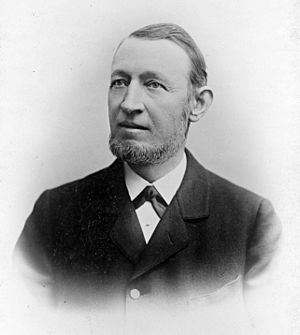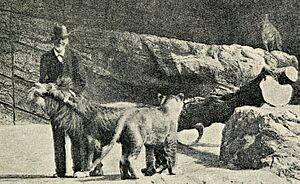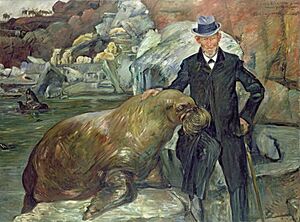Carl Hagenbeck facts for kids
Quick facts for kids
Carl Hagenbeck
|
|
|---|---|
 |
|
| Born | 10 June 1844 |
| Died | 14 April 1913 (aged 68) Hamburg, Germany
|
| Nationality | German |
| Known for | |
| Spouse(s) | Amanda (n. Mehrman) |
| Children | 2 |
| Parent(s) | Claus Gottfried Carl Hagenbeck |
Carl Hagenbeck (born June 10, 1844 – died April 14, 1913) was a German businessman. He was famous for trading wild animals and supplying them to many zoos in Europe. He also supplied animals to famous showmen like P. T. Barnum.
Carl Hagenbeck changed how zoos were built. He created modern zoo enclosures that looked more like an animal's natural home, without bars. This big change in zoo design is called the Hagenbeck revolution. He also started Tierpark Hagenbeck, Germany's most successful private zoo. It opened in Hamburg in 1907. Hagenbeck also organized shows that featured people from different cultures.
Contents
Carl Hagenbeck's Early Life and Animal Business
Carl Hagenbeck was born in Hamburg, Germany, on June 10, 1844. His father, Claus Gottfried Carl Hagenbeck, was a fishmonger. He also had a small business buying, showing, and selling unusual animals.
When Carl was 14, his father gave him some seals and a polar bear. Carl became very involved in the animal trade. His collection of animals grew so large that he needed big buildings to keep them.
Exploring the World for Animals
Carl Hagenbeck traveled far from his home in Hamburg. He went with hunters and explorers to jungles and snowy mountains. He captured animals from almost every continent in the world.
In 1874, he started to show people from different cultures, like the Samoan and Sámi people. He displayed them with their tents, weapons, and sleds, near groups of reindeer. This was a common practice in his time, but it is not done in modern zoos today.
Touring with Animals and People
Starting in 1875, Hagenbeck began to show his animals in big cities across Europe and in the United States. He wanted to make money, help preserve animals, and bring "exotic" experiences to people in industrial countries.
In 1876, he sent someone to Sudan in Africa to bring back wild animals and Nubian people. The Nubian exhibit was very popular in Europe. It toured cities like Paris, London, and Berlin. In 1880, his agent recruited a group of eight Inuit people from Labrador. This group toured Hamburg, Berlin, and Paris. Sadly, all eight Inuit died from smallpox during their travels.
Hagenbeck's shows of people were a source of inspiration for others. For example, Albert Geoffroy Saint-Hilaire organized similar "ethnological exhibitions" in Paris. These shows presented Nubians and Greenlandic Inuit to the public, which greatly increased the number of visitors to the zoo.
Hagenbeck's Circus and Zoo Innovations
Carl Hagenbeck also trained animals for his circuses. His animals performed at the World's Columbian Exposition in Chicago in 1893. They also performed at the Louisiana Purchase Exposition in St. Louis in 1904.
Hagenbeck's circus was one of the most popular attractions. It included many large animals and reptiles. Many of these animals were trained to do amazing tricks. The circus Hagenbeck put together for the Louisiana Purchase Expo was later bought and became part of the Hagenbeck–Wallace Circus. Hagenbeck's trained animals also performed at amusement parks in New York City before 1914.
Creating the Modern Zoo
Carl Hagenbeck dreamed of a permanent exhibit where animals could live in surroundings that looked like their natural homes. Even though Hamburg already had a zoo, Hagenbeck opened his own great zoo. This was the Tierpark Hagenbeck in Stellingen, near Hamburg, in 1907.
In 1909 and 1910, he helped build the Giardino Zoologico in Rome. Today, many large zoos around the world follow his ideas for animal enclosures.
Animal Expeditions and Discoveries
In 1905, Hagenbeck used his skills to capture a thousand camels for the German Empire. These camels were used in Africa. He wrote about his adventures and how he captured and trained animals in his book, Beasts and Men, published in 1909.
Hagenbeck was also one of the first Europeans to describe a creature known as Mokele-mbembe. In his book, he said he heard reports of "a huge monster, half elephant, half dragon" living in Rhodesia (now parts of Zambia and Zimbabwe). Hagenbeck thought it might be a type of dinosaur, like a brontosaurus. He searched for it but was not successful. His claims made headlines and helped start the legend of Mokele-mbembe.
Carl Hagenbeck's Legacy
Carl Hagenbeck died on April 14, 1913, in Hamburg. He died from a bite by a snake, likely a boomslang. After his death, his sons, Heinrich and Lorenz, continued the zoo and circus business. The zoo in Hamburg still carries his name today.
See also
 In Spanish: Carl Hagenbeck para niños
In Spanish: Carl Hagenbeck para niños
- Hagenbeck–Wallace Circus, a circus that included the American one founded by Hagenbeck
- Salt and Sauce, two elephants from the United Kingdom originally bought and imported by Carl Hagenbeck



